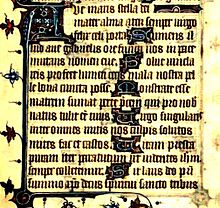Ave maris stella
 From Wikipedia the free encyclopedia
From Wikipedia the free encyclopedia

"Ave maris stella" (Latin for 'Hail, star of the sea') is a medieval Marian hymn, usually sung at Vespers. It was especially popular in the Middle Ages and has been used by many composers, as the basis of other compositions.
Background
[edit]Authorship of the original hymn has been attributed to several people, including Bernard of Clairvaux (12th century), Venantius Fortunatus (6th century)[1] and Hermannus Contractus (11th century).[2] Probably originating in the 9th century,[3] it appears as a 10th century addition in two 9th-century manuscripts, one from Salzburg now in Vienna[4] and the other still at the Abbey of Saint Gall.[5] Its frequent occurrence in the Divine Office made it popular in the Middle Ages, many other hymns being founded upon it.[1] The "Ave maris stella" was highly influential in presenting Mary as a merciful and loving Mother.[6] "Much of its charm is due to its simplicity".[7] The title "Star of the Sea" is one of the oldest and most widespread titles applied to Mary. The hymn is frequently used as a prayer for safe-conduct for travelers.[8]
The melody is found in the Irish plainsong "Gabhaim Molta Bríde", a piece in praise of St. Brigid of Kildaire.[9] The popular modern hymn Hail Queen of Heaven, the Ocean Star, is loosely based on this plainsong original.
Latin lyrics
[edit]
The Latin text of the hymn as authorized for use in the Liturgy of the Hours of the Roman Rite (Ordinary Form) is the following:[10]
Ave, maris stella, | Hail, star of the sea, |
Musical settings
[edit]| Part of a series on the |
| Mariology of the Catholic Church |
|---|
 |
| |
The plainchant hymn has been developed by many composers from pre-baroque to the present day. The Roman Rite employs four different plainchant tunes for the Ave maris stella; the first three are designated for solemnities, feasts, and memorials of the Blessed Virgin Mary;[10] a fourth is given in the Little Office of the Blessed Virgin Mary as an alternative to the memorial tone. The tunes have been used as the cantus firmus for some polyphonic settings of the mass, including those by Josquin and Victoria.[15]
Renaissance settings include those by Hans Leo Hassler, Felice Anerio, Giovanni Pierluigi da Palestrina, Guillaume Dufay and William Byrd. Baroque settings include Monteverdi's Vespro della Beata Vergine 1610, one by Emperor Leopold I, one by Louis Couperin in 1658, four settings by Marc-Antoine Charpentier (H.60, H.63, H.65, H.67 1670–1680s), and Sébastien de Brossard. Romantic settings include those by Dvorak, Grieg, and Liszt. Modern composers who have either set the text or used the hymn as an inspiration include Marcel Dupré, Flor Peeters, Peter Maxwell Davies, Grace Williams, James MacMillan, Jean Langlais, and others.[citation needed]
Acadian National Anthem
[edit]In 1884, the second Acadian national convention adopted "Ave maris stella" as the anthem of Acadia.[16]
See also
[edit]References
[edit]- ^ a b Herbermann, Charles, ed. (1913). . Catholic Encyclopedia. New York: Robert Appleton Company.
- ^ Frauenlob's song of songs by Frauenlob, Barbara Newman, Karl Stackmann 2007 ISBN 0-271-02925-0 page 100
- ^ Fassler, Margot Elsbeth (2014). Music in the Medieval West (First ed.). New York. pp. 3–12. ISBN 978-0-393-92915-7.
{{cite book}}: CS1 maint: location missing publisher (link) - ^ Cod. Vindob. 387, fol. 3v, has a fragmentary version written by a later hand (10th/11th century) in originally blank space
- ^ Codex Sangallensis 95, p. 2, has a full version written by a later hand (10th/11th century) on originally blank space
- ^ Reynolds, Brian. Gateway to heaven, New City Press, 2012, ISBN 9781565484498, p. 194
- ^ Brittain, F., Mediaeval Latin and Romance Lyric to A, Cambridge University Press, 1951, p. 79
- ^ "Ave Maris Stella Prayer", International Marian Research Institute, University of Dayton
- ^ Wood, David (2014-02-01). "Gabhaim molta Bríde". Song of the Isles. Retrieved 2019-10-24.
- ^ a b Liber Hymnarius, Solesmes, 1983.
- ^ Also spelled Hevæ.
- ^ Thus in the original, see Te Decet Hymnus, Typis Polyglottis Vaticanis, 1984, p. 255 and Liber Hymnarius, Solesmes, 1983; Pope Urban VIII's 17th-century revision has preces here.
- ^ Thus in Liber Hymnarius, Solesmes, 1983. Pope Urban VIII's text has Spiritui Sancto, Tribus honor unus.
- ^ The word "Hail" in Latin [Ave] is the reverse spelling of the Latin for "Eve" [Eva].
- ^ The Josquin companion: Volume 1 by Richard Sherr 2001 ISBN 0-19-816335-5 Page 110
- ^ "A Productive Dykeland and the Birth of a Symbol 1806–1907: The Acadian Renaissance". Landscape of Grand Pré - A World Heritage Site. Section: The Acadian Renaissance. UNESCO. Retrieved 13 May 2020.
External links
[edit]- Ave maris stella: Text, translations and list of free scores by several composers at the Choral Public Domain Library (ChoralWiki)
- "Ave Maris Stella", Benedictine Monks of the Abbey at Ganagobie on YouTube

